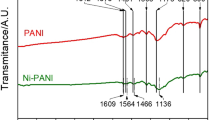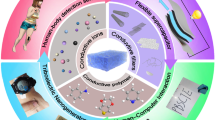Abstract
The functionalization of halloysite nanotubes (HNTs) has attracted much attention in recent years due to the nano-tubular structure and particular features. Here, we report a conductive nanohybrids of HNTs, polyaniline (PANI), and poly(sodium-p-styrenesulfonate) (PSS) with high electrical conductivity (0.11 S/cm) prepared by in situ polymerization and layer-by-layer assembly. The chemical structures and morphologies were characterized by FT-IR, UV–Vis, FE-SEM, and TEM, which confirmed that the layers of PANI, PSS, and PANI were sequentially coated onto the HNTs as expected. A study of cyclic voltammetry suggested the typical pseudocapacitance and good rate performance of the as-prepared nanocomposites. The results of galvanostatic charge/discharge and electrochemical impedance spectroscopy further demonstrated its favorable capacitive behavior and low resistance. The easily fabricated halloysite/polyaniline nanocomposites show great potential as electrode materials for supercapacitors.








Similar content being viewed by others
References
Yuan P, Southon PD, Liu ZW, Green MER, Hook JM, Antill SJ, Kepert CJ (2008) Functionalization of halloysite clay nanotubes by grafting with gamma-aminopropyltriethoxysilane. J Phys Chem C 112:15742–15751
Abdullayev E, Joshi A, Wei W, Zhao Y, Lvov Y (2012) Enlargement of halloysite clay nanotube lumen by selective etching of aluminum oxide. ACS Nano 6:7216–7226
Arcudi F, Cavallaro G, Lazzara G, Massaro M, Milioto S, Noto R, Riela S (2014) Selective functionalization of halloysite cavity by click reaction: structured filler for enhancing mechanical properties of bionanocomposite films. J Phys Chem C 118:15095–15101
Fu H, Wang Y, Chen W, Xiao J (2015) Reinforcement of waterborne polyurethane with chitosan-modified halloysite nanotubes. Appl Surf Sci 346:372–378
Cai N, Dai Q, Wang Z, Luo X, Xue Y, Yu F (2015) Toughening of electrospun poly(L-lactic acid) nanofiber scaffolds with unidirectionally aligned halloysite nanotubes. J Mater Sci 50:1435–1445. doi:10.1007/s10853-014-8703-4
Abdullayev E, Price R, Shchukin D, Lvov Y (2009) Halloysite tubes as nanocontainers for anticorrosion coating with benzotriazole. ACS Appl Mater Interfaces 1:1437–1443
Zheng P, Du Y, Chang PR, Ma X (2015) Amylose–halloysite–TiO2 composites: preparation, characterization and photodegradation. Appl Surf Sci 329:256–261
Dong F, Wang J, Wang Y, Ren S (2012) Synthesis and humidity controlling properties of halloysite/poly(sodium acrylate-acrylamide) composite. J Mater Chem 22:11093–11100
Cavallaro G, Lazzara G, Massaro M, Milioto S, Noto R, Parisi F, Riela S (2015) Biocompatible poly(N-isopropylacrylamide)-halloysite nanotubes for thermoresponsive curcumin release. J Phys Chem C 119:8944–8951
Tan WL, Salehabadi A, Mohd Isa MH, Abu Bakar M, Abu Bakar NHH (2016) Synthesis and physicochemical characterization of organomodified halloysite/epoxidized natural rubber nanocomposites: a potential flame-resistant adhesive. J Mater Sci 51:1121–1132. doi:10.1007/s10853-015-9443-9
Liu Y, Jiang X, Li B, Zhang X, Liu T, Yan X, Ding J, Cai Q, Zhang J (2014) Halloysite nanotubes@reduced graphene oxide composite for removal of dyes from water and as supercapacitors. J Mater Chem A 2:4264–4269
Liang J, Dong B, Ding S, Li C, Li BQ, Li J, Yang G (2014) Facile construction of ultrathin standing α-Ni(OH)2 nanosheets on halloysite nanotubes and their enhanced electrochemical capacitance. J Mater Chem A 2:11299–11304
Liang J, Tan H, Xiao C, Zhou G, Guo S, Ding S (2015) Hydroxyl-riched halloysite clay nanotubes serving as substrate of NiO nanosheets for high-performance supercapacitor. J Power Sources 285:210–216
MacDiarmid AG (2001) “Synthetic Metals”: a novel role for organic polymers (nobel lecture). Angew Chem Int Ed 40:2581–2590
Heeger AJ (2001) Semiconducting and metallic polymers: the fourth generation of polymeric materials. Synth Met 125:23–42
Liu F, Yuan Y, Li L, Shang S, Yu X, Zhang Q, Jiang S, Wu Y (2015) Synthesis of polypyrrole nanocomposites decorated with silver nanoparticles with electrocatalysis and antibacterial property. Compos Part B 69:232–236
Jeon JW, Kwon SR, Li F, Lutkenhaus JL (2015) Spray-on polyaniline/poly(acrylic acid) electrodes with enhanced electrochemical stability. ACS Appl Mater Interfaces 7:24150–24158
Wei D, Lin X, Li L, Shang S, Yuen MC, Yan G, Yua X (2013) Controlled growth of polypyrrole hydrogels. Soft Matter 9:2832–2836
Lu X, Zhang W, Wang C, Wen TC, Wei Y (2011) One-dimensional conducting polymer nanocomposites: synthesis, properties and applications. Prog Polym Sci 36:671–712
Bhadra S, Khastgir D, Singha NK, Lee JH (2009) Progress in preparation, processing and applications of polyaniline. Prog Polym Sci 34:783–810
Zhou C, Du X, Liu Z, Mai YW, Ringer SP (2011) Multi-holed clay nanotubes and their modification with a polyaniline nanolayer. J Mater Sci 46:446–450. doi:10.1007/s10853-010-4909-2
Zhang L, Wang T, Liu P (2008) Polyaniline-coated halloysite nanotubes via in situ chemical polymerization. Appl Surf Sci 255:2091–2097
Yah WO, Takahara A, Lvov YM (2012) Selective modification of halloysite lumen with octadecylphosphonic acid: new inorganic tubular micelle. J Am Chem Soc 134:1853–1859
Liu YS, Nan HM, Cai Q, Li HD (2012) Fabrication of halloysite@polypyrrole composite particles and polypyrrole nanotubes on halloysite templates. J Appl Polym Sci 125:E638–E643
Liu H, Xu B, Jia M, Zhang M, Cao B, Zhao X, Wang Y (2015) Polyaniline nanofiber/large mesoporous carbon composites as electrode materials for supercapacitors. Appl Surf Sci 332:40–46
Fan H, Wang H, Zhao N, Zhang X, Xu J (2012) Hierarchical nanocomposite of polyaniline nanorods grown on the surface of carbon nanotubes for high-performance supercapacitor electrode. J Mater Chem 22:2774–2780
Li Y, Zhao X, Xu Q, Zhang Q, Chen D (2011) Facile preparation and enhanced capacitance of the polyaniline/sodium alginate nanofiber network for supercapacitors. Langmuir 27:6458–6463
Kong H, Luo P, Gao C, Yan D (2005) Polyelectrolyte-functionalized multiwalled carbon nanotubes: preparation, characterization and layer-by-layer self-assembly. Polymer 46:2472–2485
Liang J, Fan Z, Chen S, Ding S, Yang G (2014) Hierarchical NiCo2O4 nanosheets@halloysite nanotubes with ultrahigh capacitance and long cycle stability as electrochemical pseudocapacitor materials. Chem Mater 26:4354–4360
Wang GP, Zhang L, Zhang JJ (2012) A review of electrode materials for electrochemical supercapacitors. Chem Soc Rev 41:797–828
Dai T, Jia Y (2011) Supramolecular hydrogels of polyaniline-poly(styrene sulfonate) prepared in concentrated solutions. Polymer 52:2550–2558
Guo H, He W, Lu Y, Zhang X (2015) Self-crosslinked polyaniline hydrogel electrodes for electrochemical energy storage. Carbon 92:133–141
Li M, Xue J (2014) Integrated synthesis of nitrogen-doped mesoporous carbon from melamine resins with superior performance in supercapacitors. J Phys Chem C 118:2507–2517
Shi Y, Pan L, Liu B, Wang Y, Cui Y, Bao Z, Yu G (2014) Nanostructured conductive polypyrrole hydrogels as high-performance, flexible supercapacitor electrodes. J Mater Chem A 2:6086–6091
Huang H, Zeng X, Li W, Wang H, Wang Q, Yang Y (2014) Reinforced conducting hydrogels prepared from the in situ polymerization of aniline in an aqueous solution of sodium alginate. J Mater Chem A 2:16516–16522
Yan J, Wei T, Shao B, Fan Z, Qian W, Zhang M, Wei F (2010) Preparation of a graphene nanosheet/polyaniline composite with high specific capacitance. Carbon 48:487–493
Fan W, Zhang C, Tjiu WW, Pramoda KP, He C, Liu T (2013) Graphene-wrapped polyaniline hollow spheres as novel hybrid electrode materials for supercapacitor applications. ACS Appl Mater Interfaces 5:3382–3391
Miao YE, Fan W, Chen D, Liu T (2013) High-performance supercapacitors based on hollow polyaniline nanofibers by electrospinning. ACS Appl Mater Interfaces 5:4423–4428
Lin LY, Yeh MH, Tsai JT, Huang YH, Sun CL, Ho KC (2013) A novel core-shell multi-walled carbon nanotube@graphene oxide nanoribbon heterostructure as a potential supercapacitor material. J Mater Chem A 1:11237–11245
Zhang L, Shi GQ (2011) Preparation of highly conductive graphene hydrogels for fabricating supercapacitors with high rate capability. J Phys Chem C 115:17206–17212
Acknowledgements
The work was financially supported by Outstanding Youth Scientific Innovation Team of Colleges and Universities in Hubei Province (T201406), the Natural Science Foundation of Hubei Province (2014CFB796), and Scientific Research Foundation of Wuhan Institute of Technology (K201508).
Author information
Authors and Affiliations
Corresponding author
Rights and permissions
About this article
Cite this article
Huang, H., Yao, J., Chen, H. et al. Facile preparation of halloysite/polyaniline nanocomposites via in situ polymerization and layer-by-layer assembly with good supercapacitor performance. J Mater Sci 51, 4047–4054 (2016). https://doi.org/10.1007/s10853-016-9724-y
Received:
Accepted:
Published:
Issue Date:
DOI: https://doi.org/10.1007/s10853-016-9724-y




